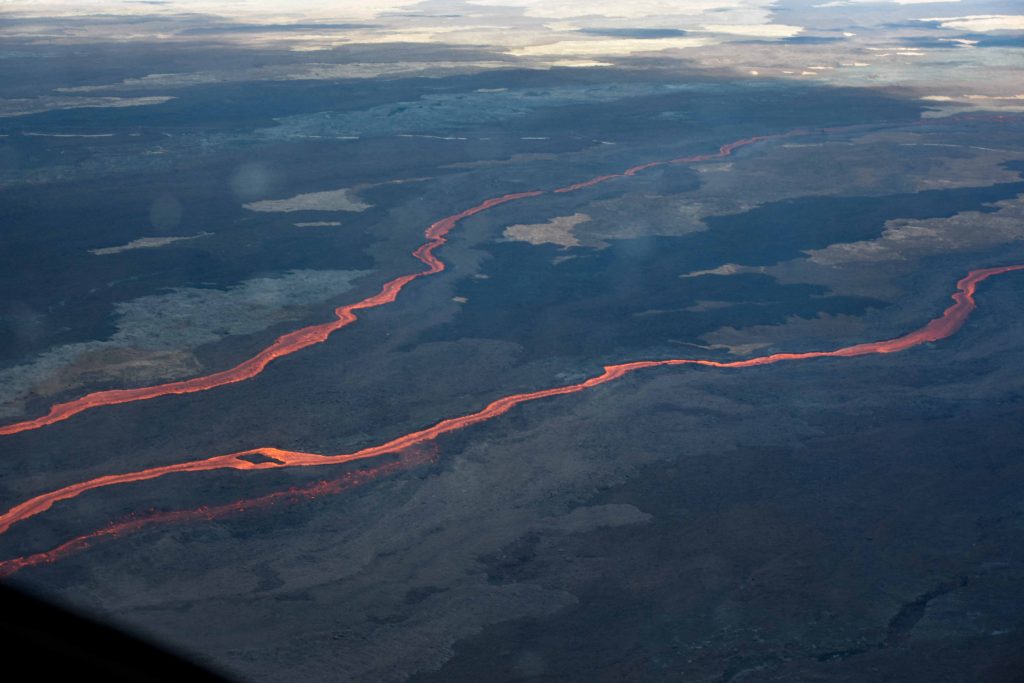Mauna Loa Eruption: Danger over for people living on southwest side of volcano

From the northeast rift of Mauna Loa, lava continues to gush out of fissure 3 at about 150 feet tall, at 50 to 100 cubic yards per second — with the flow continuing to slowly creep toward Daniel K. Inouye Highway.
As of Saturday morning, the leading edge of the flow was within about 2.5 miles of the important east-west transportation corridor of the Big Island.
But Ken Hon, Scientist-in-Charge of the Hawaiian Volcano Observatory, said there is good news for people living in the southwest rift zone of the mountain: “The threat is over.”
Hon said the observatory determined the danger was over after completing overflights of all of the eruption areas with thermal cameras and by monitoring with geophysical data.
“The activity that had gone a little bit to the southwest side of the caldera — and didn’t actually enter the southwest rift zone on the first night — is done. It’s pau,” Hon said Saturday. “People who live on the southwest side of Mauna Loa volcano, down in south Kona and Ka’u, are out of danger.”
Hon said he wanted to make sure people understood this because “I think there continues to be some anxiety because it is a big mountain and it is erupting.”
The lava flow is currently moving at just 75 feet or so per hour while it is on relatively flat ground at the divide. Right now the lava is headed toward the intersection of Saddle Road and Old Saddle Road.
“If you put water on the ground right now where the lava flow is, it would roll to the east,” Hon said. “But it is right on the boundary there. The lava flow now is over 20 feet thick, so it clearly isn’t behaving like water.
Hon said as the flow continues, it could either go east or west, with east being the more likely scenario.
But it could still turn west, which is what everyone should be rooting for because the lava flow going in that direction would be unlikely to reach Saddle Road.
“If it does go west, it will go along the Old Saddle Road. The main Saddle Road climbs there onto the slopes of Mauna Kea and is out of reach of the lava,” he said.
But now the lava is “out too far,” with too many variables, for scientists to be able to forecast if or when it will reach Saddle Road. But he said the lava flow continues to spread out, and observatory modeling shows the flow to continue to spread even more and thicken and go very slowly.
“Models run out as far as two weeks from the beginning of the eruption still donʻt have it touching the Saddle Road, but these are only approximations though and a lot of things that could happen in that flat area,” Hon said.
While the observatory is uncertain where the lava will got, Hon said: “What we want to make sure of is when it is within 24 to 48 hours of the highway that we give ample warning to Civil Defense, and the Department of Highways and things like that to make sure that all the safety measures are put in place.”
The leading edge of the lava flow also is currently 2.5 miles from Old Saddle Road, where Hawai’i County has set up a lava viewing area that runs one-way down a 4.5-mile stretch of Old Saddle Road on Pōhakuloa Training Area property.
The first night the new lava viewing area worked pretty well, but Talmadge Magno with the Hawai‘i County Civil Defense Agency said Thursday night there was some congestion because fog obstructed the lava flows, and some people were trying to do U-turns to go the wrong way on the one-way setup.
About 3,500 vehicles used the lava-viewing road on Thursday. Magno said the county would be making some tweaks to make it flow better.
“People need to plan for several hours if going in that area,” he said.
Daniel K. Inouye Highway is open in both directions, although the speed limit has been reduced to 35 mph in some areas. Motorists should plan for delays between the 28 and the 34 Mile markers on the highway.
Magno also said motorists should consider using alternative roads, including Highway 19 or 11, to get around the island.
The Hawaii Police Department reported there were five citations given for speeding and no reported crashes on Friday.
Tremors continue near the active fissures, indicating magma is still being supplied and activity is likely to continue. Hon said it is easier for scientists to predict when a volcano will erupt compared to when it will stop erupting.
Volcanic gas plumes are lofting high and vertically into the atmosphere before being blown to the west at high altitude, generating vog (volcanic gas and smog) in areas downwind. But weather conditions have mostly kept the vog high in the air and not at lower levels near the ground where it can affect people. Vog information can be found at https://vog.ivhhn.org/.
Pele’s hair (strands of volcanic glass) fragments are being wafted great distances and have been reported as far as the Mauna Kea Visitor Information Station.
For a map of the Mauna Loa lava flow, please refer to the Civil Defense Hazard Impact Map at https://www.hawaiicounty.gov/hazard-impact-map.
Most recent eruption map: https://www.usgs.gov/media/images/december-2-2022-mauna-loa-eruption-map.

Residents with questions about emergency response and resources that may be available to assist those at risk should consult https://hawaii-county-civil-defense-agency-hawaiicountygis.hub.arcgis.com/.
Hawai‘i Volcanoes National Park has closed the Mauna Loa Road from Kīpukapuaulu and the closure extends to the summit caldera; for more information please see https://www.nps.gov/havo/index.htm.
Vog information can be found at https://vog.ivhhn.org/.



